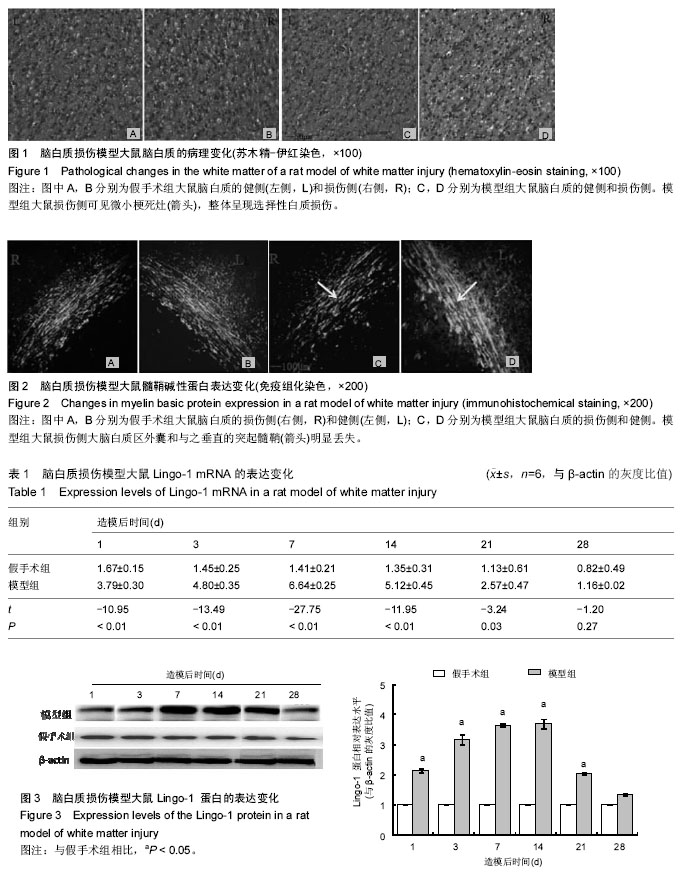| [1] 侯新琳,冯琪,汤泽中,等.早产儿脑白质损伤诊断、防治与综合管理的专家组意见[J].中国新生儿科杂志,2015, 30(3): 175-177.
[2] Back SA, Luo NL, Borenstein NS, et al. Late oligodendrocyte progenitors coincide with the developmental window of vulnerability for human perinatal white matter injury. J Neurosci. 2001;21(4): 1302-1312.
[3] Mi S, Miller RH, Lee X, et al. LINGO-1 negatively regulates myelination by oligodendrocytes. Nat Neurosci. 2005;8(6):745-751.
[4] Zhang Y, Zhang YP, Pepinsky B, et al. Inhibition of LINGO-1 promotes functional recovery after experimental spinal cord demyelination. Exp Neurol. 2015;266:68-73.
[5] Yin W, Hu B. Knockdown of Lingo1b protein promotes myelination and oligodendrocyte differentiation in zebrafish. Exp Neurol. 2014;251:72-83.
[6] 杨印祥,索磊,杜庆安,等.缺氧时间对脑白质损伤程度影响的实验研究[J].临床儿科杂志,2015(10):883-886.
[7] Hagen MW, Riddle A, McClendon E, et al. Role of recurrent hypoxia-ischemia in preterm white matter injury severity. PLoS One. 2014;9(11):e112800.
[8] Dooley D, Vidal P, Hendrix S. Immunopharmacological intervention for successful neural stem cell therapy: New perspectives in CNS neurogenesis and repair. Pharmacol Ther. 2014;141(1):21-31.
[9] Zhao XH, Jin WL, Ju G. An in vitro study on the involvement of LINGO-1 and Rho GTPases in Nogo-A regulated differentiation of oligodendrocyte precursor cells. Mol Cell Neurosci. 2007;36(2):260-269.
[10] Barrette B, Vallières N, Dubé M, et al. Expression profile of receptors for myelin-associated inhibitors of axonal regeneration in the intact and injured mouse central nervous system. Mol Cell Neurosci. 2007;34(4): 519-538.
[11] Jepson S, Vought B, Gross CH, et al. LINGO-1, a transmembrane signaling protein, inhibits oligodendrocyte differentiation and myelination through intercellular self-interactions. J Biol Chem. 2012;287 (26):22184-22195.
[12] Mi S, Sandrock A, Miller RH. LINGO-1 and its role in CNS repair. Int J Biochem Cell Biol. 2008;40(10): 1971-1978.
[13] Yin W, Hu B. Knockdown of Lingo1b protein promotes myelination and oligodendrocyte differentiation in zebrafish. Exp Neurol. 2014;251:72-83.
[14] Lv J, Xu RX, Jiang XD, et al. Passive immunization with LINGO-1 polyclonal antiserum afforded neuroprotection and promoted functional recovery in a rat model of spinal cord injury. Neuroimmunomodulation. 2010;17(4):270-278.
[15] Zhang Y, Zhang YP, Pepinsky B, et al. Inhibition of LINGO-1 promotes functional recovery after experimental spinal cord demyelination. Exp Neurol. 2015;266:68-73.
[16] Mi S, Pepinsky RB, Cadavid D. Blocking LINGO-1 as a therapy to promote CNS repair: from concept to the clinic. CNS Drugs. 2013;27(7):493-503.
[17] van Engelen BG, Pavelko KD, Rodriguez M. Enhancement of central nervous system remyelination in immune and non-immune experimental models of demyelination. Mult Scler. 1997;3(2):76-79.
[18] Rudick RA, Mi S, Sandrock AW Jr. LINGO-1 antagonists as therapy for multiple sclerosis: in vitro and in vivo evidence. Expert Opin Biol Ther. 2008; 8(10):1561-1570.
[19] Blakemore WF, Franklin RJ. Remyelination in experimental models of toxin-induced demyelination. Curr Top Microbiol Immunol. 2008;318:193-212.
[20] Fouad K, Dietz V, Schwab ME. Improving axonal growth and functional recovery after experimental spinal cord injury by neutralizing myelin associated inhibitors.Brain Res Brain Res Rev. 2001;36(2-3): 204-212.
[21] Onose G, Anghelescu A, Muresanu DF, et al. A review of published reports on neuroprotection in spinal cord injury. Spinal Cord. 2009;47(10):716-726.
[22] Andrews JL, Fernandez-Enright F. A decade from discovery to therapy: Lingo-1, the dark horse in neurological and psychiatric disorders. Neurosci Biobehav Rev. 2015;56:97-114.
[23] Petersson KH, Pinar H, Stopa EG, et al. White matter injury after cerebral ischemia in ovine fetuses. Pediatr Res. 2002;51(6):768-776.
[24] Shindo A, Liang AC, Maki T, et al. Subcortical ischemic vascular disease: Roles of oligodendrocyte function in experimental models of subcortical white-matter injury. J Cereb Blood Flow Metab. 2016;36(1):187-198. |
.jpg)

.jpg)
.jpg)